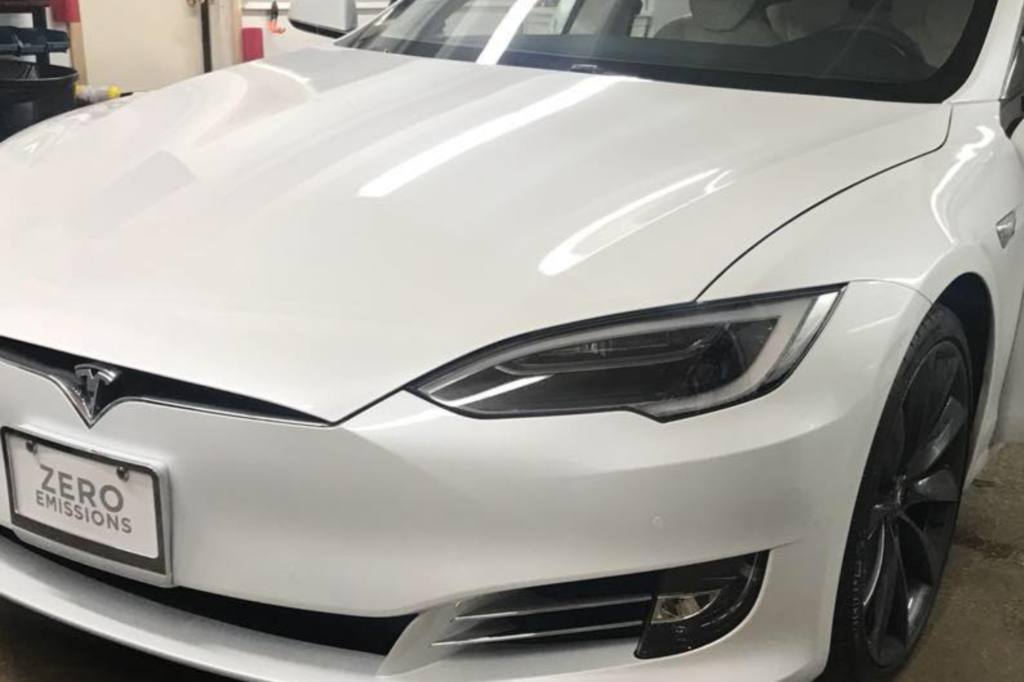Your car’s paint may fade faster than anticipated due to UV radiation, which penetrates through the clear coat, leading to oxidation and pigment degradation. Environmental contaminants like pollution, acid rain, and road salt create micro-abrasions, further compromising the paint. Poor quality paint lacking UV inhibitors exacerbates the fading process, while improper washing with abrasive materials can strip protective layers. Chemical reactions, especially oxidation accelerated by UV exposure, contribute to discoloration. To preserve your car’s finish, use high-quality wax or ceramic coatings and maintain regular washing with pH-neutral products. Discover more ways to protect your paint’s vibrant appearance.
Key Takeaways
- UV radiation and sunlight exposure degrade pigments and oxidize the clear coat, causing fading.
- Environmental contaminants like pollution and acid rain etch and damage paint, accelerating fading.
- Inferior paint quality lacks UV inhibitors, making it more susceptible to rapid fading.
- Improper washing techniques and harsh chemicals strip protective layers and cause micro-abrasions.
- Chemical reactions such as oxidation weaken the paint, increasing susceptibility to damage and fading.
Sunlight and UV Exposure
When it comes to car paint fading, sunlight and UV exposure are the most relentless adversaries. Constant UV radiation penetrates the clear coat, breaking down its molecular structure and leading to oxidation. This process not only diminishes the clear coat’s protective capabilities but also results in a dull, chalky finish. Applying a ceramic coating Dallas TX, offers a powerful solution to combat these effects. The coating forms a durable, UV-resistant layer that shields your vehicle’s paint from the sun’s harmful rays, preserving its vibrant color and glossy finish for years to come.
The pigments within the base coat are particularly vulnerable, as UV rays degrade their chemical bonds. This degradation leads to a noticeable loss of color vibrancy, especially in areas with intense sun exposure.
To combat this, you need to invest in UV protection for car paint. The regular application of high-quality wax or ceramic coatings can greatly reduce the impact of UV rays. These products create a barrier, shielding the paint from harmful radiation and slowing down the oxidation process.
Additionally, parking in shaded areas or using a car cover can provide physical protection against direct sunlight. These proactive measures not only preserve the paint’s aesthetic appeal but also extend its lifespan.
Environmental Contaminants
While UV exposure remains a primary foe of car paint, environmental contaminants are equally destructive. Pollution particles, such as industrial fallout, acid rain, and road salt, wreak havoc on your car’s finish. They etch microscopic damage into the paint, accelerating car paint fading.
These contaminants penetrate the clear coat, creating small abrasions that compromise its protective capabilities. Acid rain, formed from sulfur dioxide and nitrogen oxides in the atmosphere, can cause etching and staining, leading to a dull, worn appearance. Applying a Dallas TX ceramic coating provides a robust defense against these damaging elements. The coating creates a hydrophobic barrier that repels contaminants and prevents them from bonding to the paint, keeping your vehicle looking sleek and flawless.
Road salt, particularly in winter, is another culprit. It corrodes the protective clear coat by attracting moisture, which exacerbates rust formation. This continuous exposure to contaminants results in the breakdown of paint layers, revealing a less vibrant color.
Regular washing is essential to prevent car paint damage. Use pH-neutral soaps and soft microfiber towels to remove contaminants without causing additional scratches. Waxing your car every 3–6 months adds a protective barrier, shielding against pollutants and maintaining the paint’s integrity.
Through these proactive measures, you can greatly reduce the impact of environmental contaminants, preserving your car’s aesthetic appeal and longevity.
Poor Quality Paint
Poor-quality paint can greatly contribute to the rapid fading of your car’s finish. Manufacturers sometimes use inferior paint materials to cut costs, which compromises the paint’s longevity and durability. These low-grade paints often lack essential UV inhibitors and stabilizers, making them more susceptible to UV radiation damage. As a result, the paint’s chemical bonds break down faster, leading to oxidation and a dull, chalky appearance. This is one of the primary reasons that many car owners face unexpected car paint fade.
To mitigate this issue, you need to guarantee that your car is coated with high-quality paint from the start. High-quality paints contain a robust mix of pigments and resins that offer superior UV protection and resistance to environmental contaminants.
If your vehicle has already been painted with subpar materials, consider applying a high-grade clear coat or ceramic coating. These products provide an additional protective layer, shielding the paint from harmful UV rays and pollutants.
Regular maintenance is also vital to prevent car paint from fading. Wash your car with pH-neutral soap and use microfiber towels to avoid scratching.
Regular waxing will further safeguard the paint, maintaining its vibrancy and shine.
Improper Washing Techniques
Although often overlooked, improper washing techniques can greatly accelerate car paint fading. When you use abrasive sponges or harsh chemicals, you inadvertently strip away your vehicle’s protective clear coat. This clear coat acts as a shield against UV rays and pollutants, which are vital factors in why car paint fades.
Automatic car washes, especially those with stiff brushes, can introduce micro-abrasions, further compromising the finish. These minute scratches accumulate, allowing sunlight and contaminants to penetrate and degrade the paint layers beneath.
Proper washing is pivotal. Opt for pH-neutral soaps and soft microfiber towels to cleanse gently without inflicting damage. Consider the benefits of ceramic coating Dallas TX services, which provide an extra layer of protection. This advanced coating bonds with your car’s paint, enhancing its resistance to UV rays and environmental contaminants while preserving its glossy, showroom-like finish for years to come.
Regular maintenance, including proper drying techniques, is essential. Air drying under the sun can lead to water spots, accelerating fading. Instead, use high-quality towels to avoid micro-scratches.
Chemical Reactions
Maintaining your car’s exterior involves more than just proper washing techniques; understanding the chemical reactions affecting the paint is equally important. The paint on your vehicle is a complex composition, vulnerable to various chemical interactions.
One primary culprit is oxidation, a chemical reaction where oxygen molecules interact with the paint’s outer layers. This process gradually breaks down the paint’s molecular structure, resulting in discoloration and a chalky surface. Oxidation is particularly aggressive when catalyzed by UV radiation, which accelerates the deterioration by breaking chemical bonds within the paint.
Additionally, pollutants like sulfur dioxide and nitrogen oxides, prevalent in urban environments, react with moisture in the air to form acid rain. These acidic droplets can etch into your car’s paint, further exacerbating fading and promoting surface roughness. This reaction not only diminishes the paint’s visual appeal but also weakens its protective capabilities, leaving the underlying layers more susceptible to damage.
Understanding these chemical reactions highlights the importance of proactive maintenance. Regular washing to remove contaminants and applying protective coatings can mitigate the impact of these reactions, preserving the vibrant look and structural integrity of your car’s paint over time.
Lack of Protective Coating
Without a robust protective coating, your car’s paint is left vulnerable to the damaging effects of environmental elements and chemical reactions. The clear coat acts as a barrier against UV radiation, pollutants, and moisture.
Without it, your car’s paint is exposed to oxidation, where oxygen molecules break down the paint’s chemical structure, leading to fading and a dull appearance. Additionally, acid rain and road salt can penetrate unprotected paint, causing corrosion and expedited degradation.
When you neglect to apply protective coatings like wax or ceramic sealants, you’re not just risking your car’s aesthetics; you’re reducing its longevity. These coatings form a sacrificial layer that absorbs damage before it reaches the paint. They also make the surface easier to clean, preventing contaminants from embedding in the paint and causing micro-abrasions.
To maintain your car’s paint, apply a ceramic coating or wax every few months. These steps greatly reduce UV exposure and contaminant adhesion, prolonging your vehicle’s vibrant look.
Investing in regular maintenance guarantees your car remains visually appealing and retains its value over time, sparing you costly repainting.
In Summary
J’s Tint & Car Audio recommends prioritizing protection against UV rays by parking in shaded areas or using car covers. Regularly wash your vehicle with pH-balanced solutions to remove contaminants and always rinse thoroughly. Apply high-quality wax or sealant for an effective protective coating. Opt for professional-grade paint when possible, and avoid harsh chemicals that might trigger adverse reactions. By implementing these strategies, you’ll markedly slow down paint fading, keeping your car looking pristine for years.

